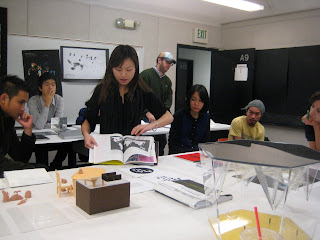Dear all, we are merging both studios for our final. See Below
------------------------------------------------------------------------------
FINAL PRESENTATION PARAMETERS: looks dense, but its just very detailed and specific to avoid any confusion.
Below are the specifications on how I want the class to be set up for your final presentation (sketch, up for revision on site if need be)
The format will be an open / public exhibition of the work you have created this term in Transmedia (both studios combined)
Two of you (alexis and jesse) have classes at that time. Please advise on when you can drop by to present your work during break, we will accommodate.
i will invite colleagues and I invite you to spread the word to your peers as well. Nico Sala is designing our promo poster which should be up in school friday.
Exhibition time: 2:30-7pm. Open critique led by Carolina Trigo
location: room A9 / annex
We will begin the critique at 2:30 pm, meaning an extra 30 min to set up, so please get there a bit early (1:30pm)
as we need to arrange the tables and projectors.
Tables should be covered by white butcher paper for a very clean, elegant and professional presentation.
Butcher paper should drape to the ground on longer lateral sides of table.
-----------------------------------------------------------------------------------------
WORK:
Below are the required deliverables for your final: essentially, BRING ALL YOUR WORK IN FINAL AND ACTUAL FORMAT. ALL MEDIA INCLUDED.
—Models
—Catalog
—Poster/s: (do not mount!, we will pin these to the wall with clips or magnets, I don't like mounted posters and I don't want you to ruin your prints, I am very aware of how expensive they are)
—Invite
—Website
— Process book: This is not meant to be designed, just french-fold all your 11 x 17 printouts / sketches / work from the term and perfect-bind.
Add a simple structure to it, meaning, dividers that state: stage 1. stage 2 etc. You can name these however you see fit. Needs cover, spine, back cover.
—Media work: Video, Sound, Performance, documentation in actual format, these will be screened in projector 2. If sound, they will be played. (we need speakers)
-----------------------------------------------------------------------------------------
WEBSITE REQUIREMENTS:
—web needs to be functioning.
—remember, indexhibit is a suggestion, if you have a website already or prefer cargo collective or dreamweaver that's fine,
use your criteria to execute what works best for you.
REQUIRED LINKS / CONTENT: 'PHYSICAL' IMAGES OF ALL YOU WORK (the idea here is that you show everything as a final, executed, physical object)
—Logo (ideally placed to one side, elegant, visible on all pages)
—Artist Statement
—Space: aka, images of your exhibition space or site-specific interventions (models / performance etc) Presented as a narrative sequence / visual storytelling. This is what you did in your book, just translate that into an online platform via images. They should be arranged in a way that presents your work in a cohesive and sequential manner.
—Catalog: shoot your final (PHYSICAL) book and include it as an image narrative. select the best spreads that tell the story in sequence.
—Poster: Shoot your poster. For this one you can also add a JPEG of your final layout
—Invite: shoot your printed invite. Can also include JPEG
—Process book: Shoot your final book. Same as catalog (this one is optional)
-----------------------------------------------------------------------------------------
SCREEN-BASED MEDIA (2 Projectors)
—FOR PROJECTOR 1: ongoing loop
Select the best images of your exhibition space. 6-10 images minimum. Use the images Pascual Sisto shot alongside yours. Select the best.
We will compile these into one folder and present as a slideshow loop throughout the evening. Include a black slate at the beginning of your sequence including:
logo (project name) & your name,
(btw: Pascual Sisto was our photographer, please credit him accordingly. He did great work for us mostly based on our friendship, and I'd like to ask for a donation for his time, I think $10 are appropriate.) He's a dear friend of mine and a very talented artist, (also an accd graduate) he donated his time and stayed till midnight shooting work. You can view his work at: http://www.pascualsisto.com/
—FOR PROJECTOR 2: presentation-specific (as it will be hard to compile all into one movie)
here's where we will screen all you video, sound, performance and documentation work; so please bring these in as they are required deliverables. Compile into one movie.
Each student should arrange their pieces as follows: include a black slate at the beginning of your projects including: your name & project name (or logo, small)
These will be screened / heard when you present your work to us.
-----------------------------------------------------------------------------------------
PRESENTATION LABELS:
Please create the following and place / present next to your work:
— All labels should be 8" x 8". Mounted on foamcore. BW prints will do, unless you are inclined to use colour.
—8 x 8 label #1: Project Logo. Centered on the square.
—8 x 8 label #2: Your name(s)
—8 x 8 label #3: Artist statement.
(note: #2 & #3 can be combined. Just make sure they look beautiful typographically. Use the language you already have established in your book, don't re-invent the wheel!)
I think this is it, If I forgot something I'll post.
Good luck on this final stretch. I am very much looking forward to your work!
Excellence is where it's at.
all my best,
carolina








































